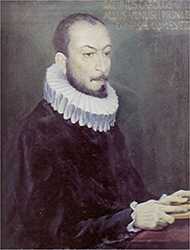
 i noted yesterday Sciarrino’s interest in Carlo Gesualdo, and so today, as Holy Week moves into the Triduum, here is a complete recording of Gesualdo’s setting of the Tenebrae Responsories for Maundy Thursday. Tenebrae is a remarkable service that’s rarely used today; it was created by combining the morning offices of Matins and Lauds, and then celebrating them in the late evening of the day before, so Tenebrae for Maundy Thursday would conventionally have taken place on Wednesday evening. It was a service with considerable ceremonial drama, with an elaborate candlestick—known as a ‘tenebrae hearse’—at its epicentre; throughout the service these candles would be gradually extinguished until only one remained (back in 2009 i posted a complete service of Tenebrae from Westminster Cathedral, which you can find here). Gesualdo’s music sets the nine responsories from the Matins part of Tenebrae (Lauds is primarily made up of psalms and antiphons). They fall into three ‘nocturns’, each containing three responsories; the first nocturn focuses on Christ in the garden of Gethsemane, the second switches attention to Judas, and the third widens the scope to show how pretty much everyone played their part in Jesus’ betrayal.
i noted yesterday Sciarrino’s interest in Carlo Gesualdo, and so today, as Holy Week moves into the Triduum, here is a complete recording of Gesualdo’s setting of the Tenebrae Responsories for Maundy Thursday. Tenebrae is a remarkable service that’s rarely used today; it was created by combining the morning offices of Matins and Lauds, and then celebrating them in the late evening of the day before, so Tenebrae for Maundy Thursday would conventionally have taken place on Wednesday evening. It was a service with considerable ceremonial drama, with an elaborate candlestick—known as a ‘tenebrae hearse’—at its epicentre; throughout the service these candles would be gradually extinguished until only one remained (back in 2009 i posted a complete service of Tenebrae from Westminster Cathedral, which you can find here). Gesualdo’s music sets the nine responsories from the Matins part of Tenebrae (Lauds is primarily made up of psalms and antiphons). They fall into three ‘nocturns’, each containing three responsories; the first nocturn focuses on Christ in the garden of Gethsemane, the second switches attention to Judas, and the third widens the scope to show how pretty much everyone played their part in Jesus’ betrayal.
It’s perhaps not surprising that Gesualdo’s compositional style should continue to sound radical and strange into the 21st century. As i mentioned briefly yesterday, his life certainly had its share of drama, and the considerable anguish he wrought upon himself—he never lived down the crimes passionnels for which he is equally famous—can be heard paralleled in the distressed pungency of the Tenebrae Responsories. Composed in 1611, just two years before his death, they are a total departure from the smooth fluidity that characterises the polyphony of Palestrina and Victoria; to my mind, he draws similarities with his almost exact contemporary El Greco, whose work was equally at odds with the prevailing tempora and mores. In particular, Gesualdo’s use of chromaticism, used to pull chords in the most bizarre, oblique directions, is genuinely groundbreaking, and the way he would alternate between episodes like this and more traditional, diatonic passages only makes his music sound even more extraordinary. In a work like the Tenebrae Responsories, of course, such techniques seem to modern ears highly appropriate, heightening the intensity of the unfolding Holy Week narrative, now moving swiftly towards its nadir. The second responsory, Tristis est anima mea, demonstrates this especially strongly, Jesus’ words of sorrow carried on the most uncomfortably shifting chords, seeking anything approximating a cadence. Gesualdo breaks the music’s reserve at the accusation that the apostles will all flee, only then to resume an even more tragically sombre tone at the final thought of becoming a human sacrifice. Each of the responsories has its own moments like these; together (and alongside Gesualdo’s Responsories for Good Friday and Holy Saturday) they remain one of the most horribly vivid pieces of Holy Week music ever composed.
This performance dates back a good many years (i’ve lost the exact date), but took place on Maundy Thursday at the Temple Church in London. It was given by the wonderful Hilliard Ensemble, and as one would expect from them, is a remarkably faithful and heartfelt rendition of Gesualdo’s music.
